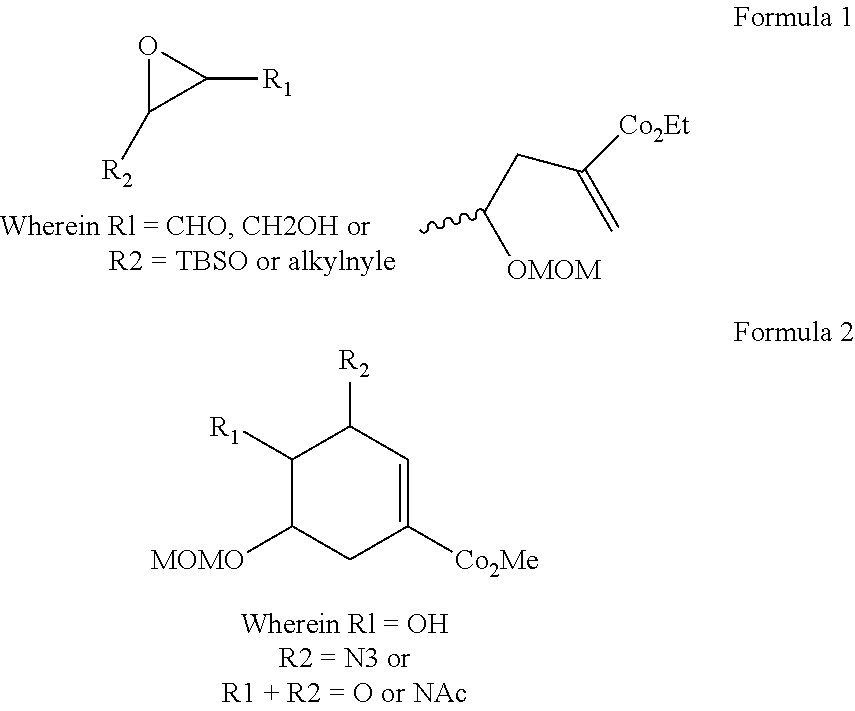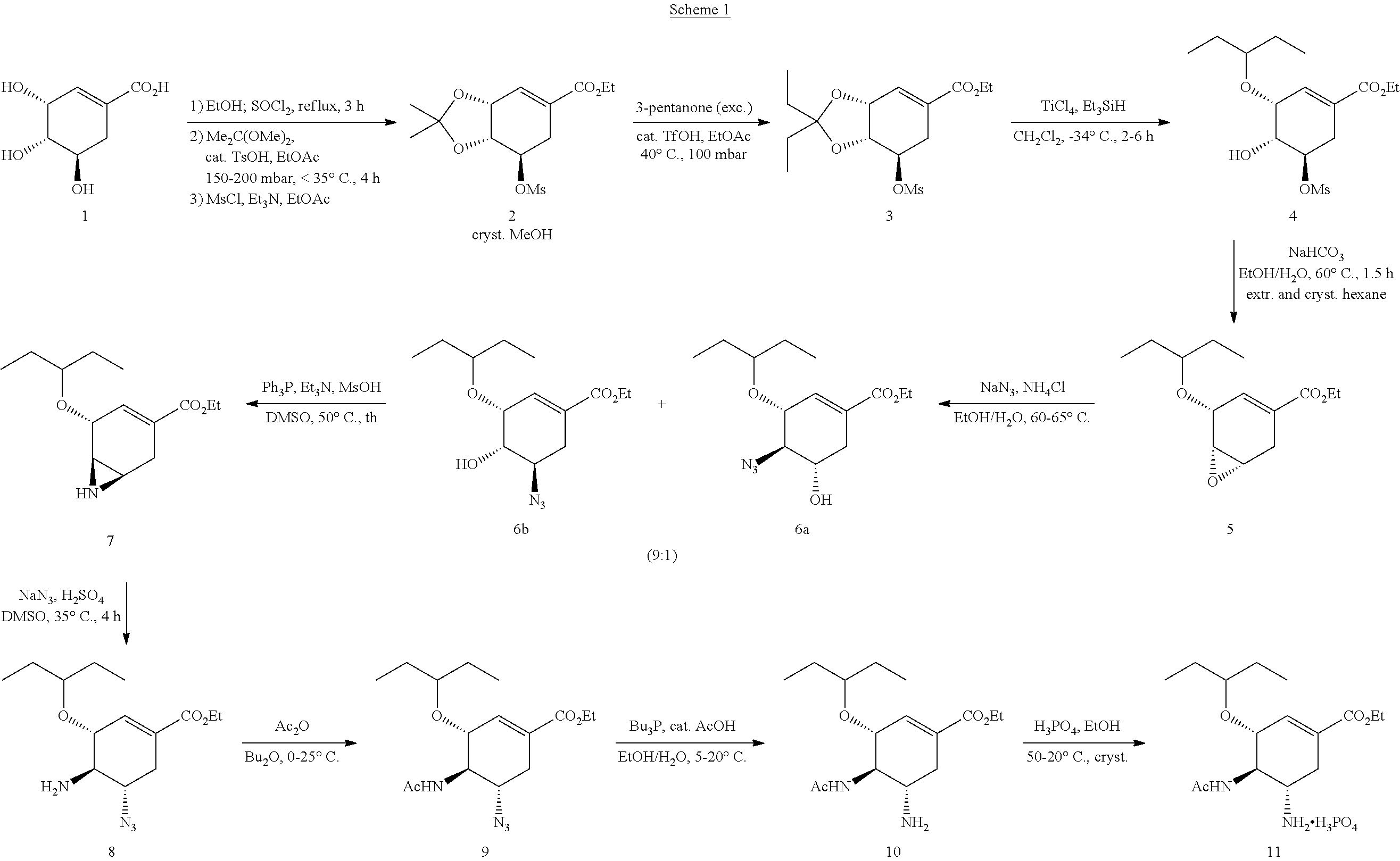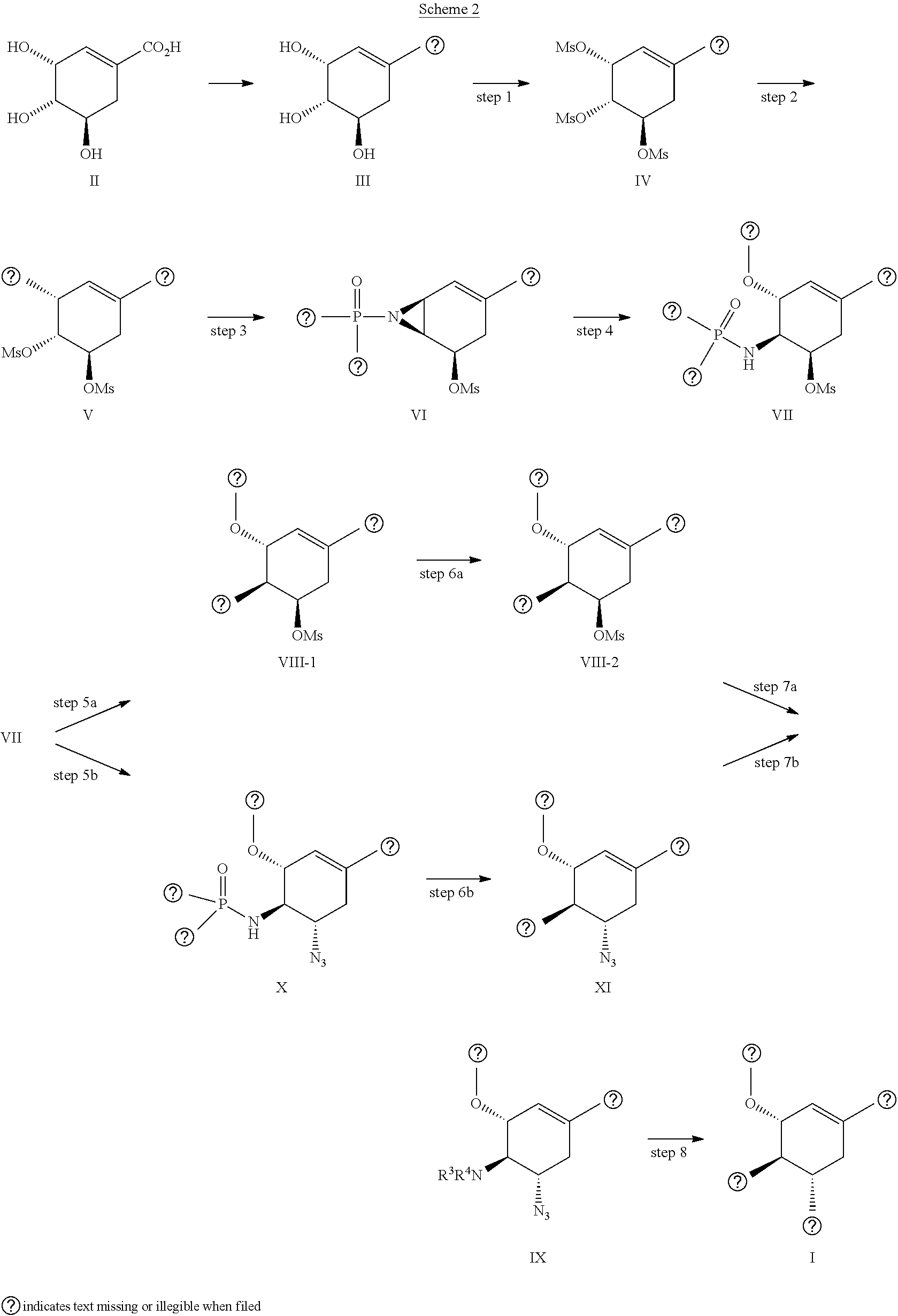Process for the preparation of oseltamivir and methyl 3-epi-shikimate
a technology of methyl 3epishikimate and oseltamivir, which is applied in the preparation of carboxylic acid amides, amino-carboxyl compound preparations, organic chemistry, etc., can solve the problems of limited supply of ()-shikimic acid of consistent purity, affecting the commercial production of oseltamivir from the biomolecule shikimic acid or its enantiomer, and affecting the production efficiency of osel
- Summary
- Abstract
- Description
- Claims
- Application Information
AI Technical Summary
Benefits of technology
Problems solved by technology
Method used
Image
Examples
example 1
(Z)-4-(tert-butyldimethylsilyloxy)but-2-en-1-ol, (7)
[0088]
[0089]To a solution of cis-1,4-butene diol (6) (20.0 g, 227.27 mmol) in dry CH2Cl2 (700 mL) at 0° C. was added imidazole (23.21 g, 340.91 mmol) and tert-butyldimethylsilyl chloride (37.68 g, 250.0 mmol). The reaction mixture was stirred at 0° C. for 6 h. After completion of reaction (monitored by TLC), it was diluted with CH2Cl2 (500 mL) washed with water, brine and dried over anhydrous Na2SO4. Removal of solvent under reduced pressure gave the crude product which was then purified by column chromatography with petroleum ether / EtOAc (9:1 v / v) to give (7) as a colorless liquid.
[0090]Yield: 73%; colorless liquid; IR (CHCl3): 777, 837, 1033, 1088, 1255, 1471, 2857, 2929, 3354 cm−1; 1H NMR (200 MHz, CDCl3): δ 0.04 (s, 6H), 0.86 (s, 9H), 2.2 (brs, 1H), 4.17-4.26 (m, 4H), 5.57-5.61 (m, 2H); 13C NMR (50 MHz, CDCl3): 6-5.3, 18.3, 25.9, 58.6, 59.5, 130.1, 131.1; Anal. Calcd for C10H22O2Si requires C, 59.35; H, 10.96. Found: C, 59.38; ...
example 2
((2S,3R)-3-((tert-butyldimethylsilyloxy)methyl)oxiran-2-yl)methanol, [(+8]
[0091]
[0092]To a stirred suspension of powdered 4 Å molecular sieves (10.0 g) in dry CH2Cl2 (700 mL), titanium tetraisopropoxide (5.6 g, 20 mol %) was added under nitrogen atmosphere. The reaction mixture was cooled to −10° C. and (+)diethyl tartrate (4.4 g, 30 mol %) added and stirred for 10 min. To the above solution, tert-butyl hydroperoxide 5-6 molar solution in decane (35.2 mL, 2 equiv.) was added and stirred at −10° C. for further 30 min, after which allylic alcohol 7 (20 g, 98.83 mmol) dissolved in dry CH2Cl2 (150 mL) was added and stirred at −10° C. for 12 h. After completion of the reaction (monitored by TLC), the reaction mixture was quenched with 1M NaOH (25 mL) with further stirring for 1 h at −10° C. The organic layer was then separated, washed with brine solution, dried over anhyd. Na2SO4 and concentrated under reduced pressure. The crude compound was purified by column chromatography using petro...
example 3
(2R,3R)-3-((tert-butyldimethylsilyloxy)methyl)oxirane-2-carbaldehyde, [(+)-9]
[0095]
[0096]To a solution of epoxy alcohol (+)-8 (15.0 g) in dry CH2Cl2 was added in one portion bis-acetoxy iodobenzene (24.34, 75.6 mmol) and TEMPO (1.07 g, 6.9 mmol). The reaction mixture was then allowed to stir at 25° C. for 1 h. After completion of reaction (monitored by TLC), the reaction mixture was quenched by addition of saturated solution of aq. ammonium thiosulphate (log in 100 mL water). The organic layer was separated, washed with brine and subjected to column chromatographic purification with petroleum ether / ethyl acetate (9:1 v / v) to afford the epoxy aldehyde (+)-9.
[0097]Yield: 95%; yellow liquid; [α]D25 +43.0 (c 3.0, CHCl3).
[0098]IR (CHCl3): 778, 838, 1099, 1256, 1472, 1720, 2858, 2930 cm−1; 1H NMR (200 MHz, CDCl3): δ 0.08 (s, 6H), 0.89 (s, 9H), 3.34-3.44 (m, 2H), 3.90-4.09 (m, 2H), 9.47 (d, J=4.2 Hz, 1H); 13C NMR (50 MHz, CDCl3): δ−5.5, 18.2, 25.7, 57.4, 59.8, 60.1, 197.4; Anal. Calcd. for...
PUM
| Property | Measurement | Unit |
|---|---|---|
| Temperature | aaaaa | aaaaa |
| Temperature | aaaaa | aaaaa |
| Temperature | aaaaa | aaaaa |
Abstract
Description
Claims
Application Information
 Login to View More
Login to View More - R&D
- Intellectual Property
- Life Sciences
- Materials
- Tech Scout
- Unparalleled Data Quality
- Higher Quality Content
- 60% Fewer Hallucinations
Browse by: Latest US Patents, China's latest patents, Technical Efficacy Thesaurus, Application Domain, Technology Topic, Popular Technical Reports.
© 2025 PatSnap. All rights reserved.Legal|Privacy policy|Modern Slavery Act Transparency Statement|Sitemap|About US| Contact US: help@patsnap.com



